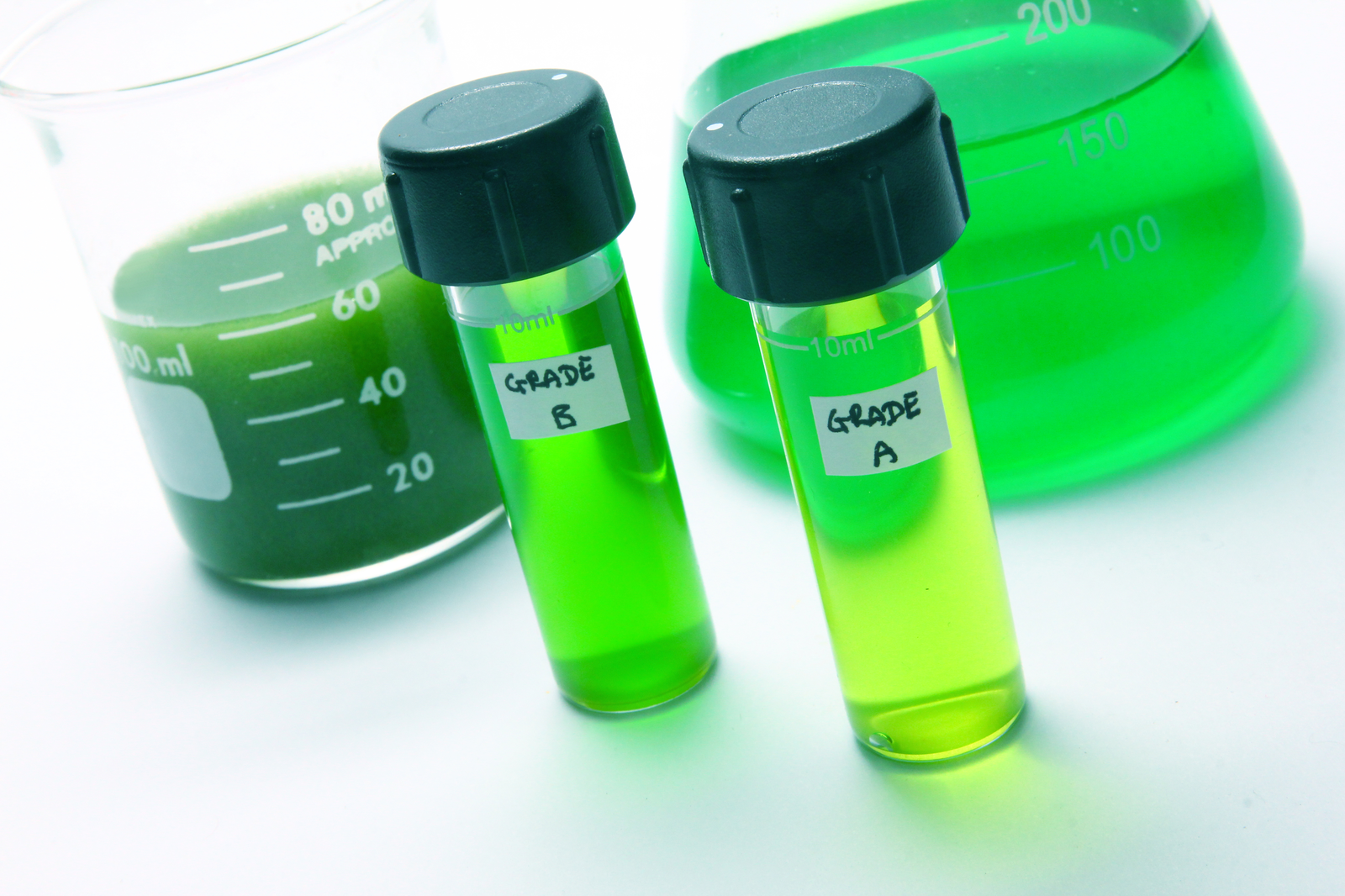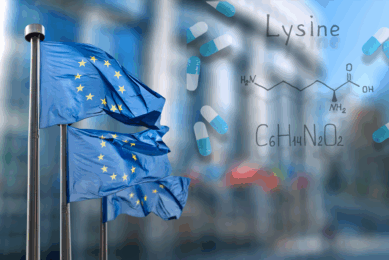Microalgae in animal feed

De-fatted microalgal biomass, a by-product ?from biofuel production, may serve as a new generation ingredient for animal diets. It also ?has potential to add value to the end products.
By Krystal K Lum, Jonggun Kim and
Xin Gen Lei, Cornell University, USA
Although the use of whole microalgae in animal diets has long been studied, the de-fatted biomass of microalgal species, derived from biofuel production research, has only recently shown feasibility in replacing corn and soybean meal in animal diets. De-fatted biomass is derived when lipids are extracted from algae to create biofuel.
Nutritional value
While the nutritional profiles of microalgae vary considerably with the species used, a large majority are characterised by protein, carbohydrate, and lipid contents that are comparable, if not superior, to conventional feedstuffs. Dietary soybean meal typically contains up to 48% crude protein, and lays claim to a relatively well balanced amino acid profile. The diversity of microalgae makes certain species amenable to cultivation for diet-specific needs of humans and animals. A commonly cultivated algae species for human consumption: S. maxima, contains high levels of vitamin B1, vitamin B2, and β-carotene, and up to 71% crude protein with sufficient concentrations of all essential amino acids except for the sulfur-containing ones. Since protein is considered to be the most expensive nutrient in animal feed, developing natural alternatives to soybean meal may be cost competitive. Among all dietary amino acids, lysine and methionine are the first and second limiting amino acids. Many microalgal species contain relatively high amounts of lysine, but are somewhat deficient in the sulfur-containing amino acids: cysteine and methionine. To maximise amino acid utilisation by animals, diets are typically formulated by mixing different feedstuffs to balance amino acid profiles and (or) by supplementing synthetic amino acids to meet their nutrient requirements.
Poultry and pigs
Austic et al. replaced 7.5% of soybean meal with the de-fatted biomass of the Staurosira sp. in the diets of broilers, and showed decreased body weight gain and feed efficiency during the first three weeks of experiment. During the following three weeks, these differences were no longer seen. In the same study, broiler chicks fed a diet containing essential amino acids (Met, Lys, Ile, Thr, Trp and Val) co-supplemented with 7.5% of the de-fatted biomass did not show growth performance differences from the control group. In another study conducted on laying hens, an inclusion of 10% Porphyridium sp. red algal biomass did not affect their body weight, egg production rate, or egg weight, but lowered egg yolk cholesterol levels by 24%. Up to a third of soybean meal was successfully replaced in the diets of weanling pigs by algae biomass from the cyanobacteria S. maxima, Arthrospira platensis, and Chlorella sp. Other studies showed that supplementing the de-fatted biomass from the algae specie Staurospira sp. to replace 7.5% corn and soybean meal in diets for weanling pigs did not affect their overall growth performance or plasma biochemical indicators. However, the pigs were incapable of tolerating a 15% replacement of corn and soybean meal. Factors causing this intolerance might include amino acid imbalances, disruption of the acid: base balance, high ash content of the algal biomass, and (or) an overall reduction in the buffering capacity within the gastrointestinal tract of the weanling pigs.
Rabbits and ruminants
A diet with 10% lipid-extracted Nannochloropsis oculata meal was well tolerated by adolescent male rabbits, which showed similar final body weight, serum urea nitrogen, blood glucose, and organ histology in comparison with rabbits fed a control diet. Finishing wethers maintained similar growth performance and carcass characteristics (longissimus muscle area, dressing percentage, marbling score, hot carcass weight, and subcutaneous adipose depth) when fed up to 20% de-fatted algal biomass on a dry matter basis as a protein replacement, in comparison with wethers (male sheep) fed a control diet. In a study that examined effects of supplementing dietary dry matter with de-fatted Lithothamnium calcareum meal in Holstein cows, up to 1% algal meal in the diet mediated venous acid–base balance after acidosis induction, but did not improve the tract digestibility or growth performance of the cows.
Adding value
Microalgal biomass supplementation could not only benefit animal diets, it also can add value to the end products, hence promoting human health. A study conducted in the last decade showed not only 10% enhancement of growth but also potential in producing iodine-rich pork for human consumption when pigs were fed algae containing naturally high iodine. Likewise, microalgae may be cultivated for their advantageous fatty acid profile with notable enrichment in omega-3 (n-3) polyunsaturated fatty acids (PUFA) including arachidonic acid, docohexaenoic acid (DHA), eicosapentaenoic acid (EPA), and γ–linoleic acid. Microalgal biomass or oil may be supplied in the feed of ruminants to manipulate their milk fatty acid composition. The content of n-3 fatty acids in milk, especially DHA, has been shown to increase with the inclusion of algal biomass or oil, without affecting the milk yield. However, a study with similar dietary algae incorporation reported a decrease in milk fat content. Likewise, fatty acid compositions in meats and eggs are also affected by dietary supplementations of microalgae. In lambs and horses, dietary microalgae increased the n-3 fatty acid content in meat and blood, respectively. In pigs, dietary microalgae increased DHA concentrations in the loin and subcutaneous fat. However, this increment did not manifest as a dose-dependent response. To enrich eggs with n-3 fatty acids, flaxseed is usually supplemented in diets of laying hens. Alternatively, dietary algae have been shown to increase n-3 and decrease n-6 fatty acids in eggs. Supplementing flaxseed at 10% or higher usually decreases egg production and the body weight of hens. Moreover, such high flaxseed supplementations may induce fatty acid oxidation, resulting in off-odour eggs. Herber and Van Elswyk supplemented up to 4.8% of golden marine algae into the diet of hens, and reported increased levels of DHA with a concomitant reduction of n-6 fatty acids. The inclusion of algae in the diet affected neither the egg production nor egg quality in the 56 wk-old hens. When up to 4.3% of fermented Schizochytrum sp. was included in the diets of hens, their egg production and feed conversion ratio were elevated. The 0.86% and 4.3% supplementation of the microalgae elevated the DHA content to 134 and 220 mg/egg, respectively.
Special considerations Despite their high nutritional values and health implications, caution must be taken to avoid possible toxicity of the microalgal biomass. Among over 200,000 existing algal species, approximately 35,000 species are characterised without apparent toxicological property. However, certain species contain biogenic toxins including purines and non-biogenic toxins such as heavy metals. Some algal species are known to rapidly accumulate heavy metals at concentrations higher than their surroundings, while others generate pathological metabolites that cause neuro-degenerative disorders. Such species require establishment and evaluation prior to their commercialisation as feed supplements. Currently, no official regulations for heavy metals in microalgal products exist. In spite of the relatively high crude protein contents, many microalgae species may still show limited biological values for the proteinaceous biomass due to the presence of non-protein nitrogen that consists of nucleic acids, nitrogen-containing cell walls, and amines.
Conclusions
The use of microalgal biomass in animal feed will not only improve human and animal food security, but also facilitate cost-effective biofuel production and reduces greenhouse gas production of agriculture. But despite their high nutritional values and health implications, caution must be taken to avoid possible toxicity of the microalgal biomass. Among over 200,000 existing algal species, approximately 35,000 species are characterised without apparent toxicological property. Currently, no official regulations for heavy metals in microalgal products exist. Regarding further research, it is necessary to determine limiting factors of the microalgal biomass that hinder its digestion and utilisation by animals. Novel technology should be explored to improve microalgal nutrient utilisation, and their long term nutritional and metabolic effects should be assessed. However, the tremendous potential of using the microalgal biomass in producing DHA/EPA enriched eggs, meats, and milk for improving human health is yet to be fully explored.
This article has been edited from the original paper: ‘Dual potential of microalgae as a sustainable biofuel feedstock and animal feed’, published in the Journal of Animal Science and Biotechnology 2013, 4:53.
[Source: AllAboutFeed magazine Vol 22 nr 2, 2014]











